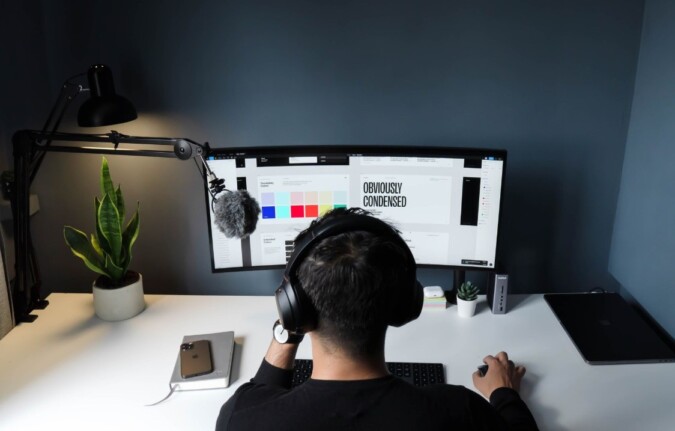Working professionals used to live in extremes. Either you were a full-time contractor bouncing between clients, or you kept a steady job and watched your creative spark slowly fade in the name of stability. Still, even for full-time freelancers, it hasn’t been a completely rosy path.
A 2024 report by Leapers found that 86.3% of freelancers felt that irregular income negatively impacted their mental health, with 49.9% experiencing significant stress due to the unpredictability.
But today, there’s a growing middle ground that makes a lot more sense– the hybrid career. This refers to a combination of freelancing and full-time work. It’s somewhat tricky to set up, but when it works out, you create a career that includes the best elements of both worlds. If that sounds interesting to you, then read on.
1. Learn How to Pick Your Anchor and Build Around It

Every hybrid career needs a strong foundation. In the freelance world, that foundation is your anchor. It’s a consistent and reliable source of income that supports the rest of your hustle. It could be a part-time job, a long-term contract with a single client, or even a monthly retainer that brings in regular income. Whatever it is, you need an anchor if you operate on two fronts.
Working multiple jobs isn’t new, by the way. Data shows that as of March 2025, there were over 9.132 million people in America working several jobs at the same time. This represents 5.6% of civilian employment, and it’s the highest it’s been since 2004.
Having an anchor of stability is of massive help because you dont wake up every day worrying if you can make rent this month. When you have your basic expenses covered, you get to say yes to projects that genuinely excite you. This also gives you the time to start taking your freelancer side more seriously and building it to be more professional.
Let’s say you’re based in a smaller town or working from home. That doesn’t mean your freelance business has to look small. The fact is that setting up a virtual business address in New York or a big city like it can instantly elevate how you’re perceived.
A Manhattan address, for instance, gives the impression that you’re plugged into a competitive, high-performing market. Like it or not, this subtly influences how potential clients view you, and that allows you to charge higher rates as well.
As The Farm Soho also notes, you also get the advantage of a permanent address, which is a big deal if you travel frequently. So, not too bad a deal when you consider how affordable they can be.
2. Know Your Non-Negotiables First

Now, there’s another key aspect you need to know to make a hybrid career work. This aspect is to know what your hard requirements are. As freelancers, you often get into the ‘adjusting’ mindset, but with a hybrid career, you need to set clear boundaries and expectations for yourself. If you’re unsure where to start, let’s begin with income.
How much do you need to make every month to really feel safe? If it’s just to meet basic needs, then data shows that about $96,500 for a two-parent household would be enough. Meanwhile, if wealth is what you’re looking for, that’s another story. Recent surveys show that the average American believes $520,000 is the figure needed to be ‘wealthy.’
Naturally, income is just one factor. Do you require health benefits, or are you comfortable sourcing them on your own? What kind of work gives you energy instead of draining it? Do you need full flexibility over your schedule, or can you commit to a few set hours a week?
Once you get brutally honest about these things, you’ll start to see what kind of hybrid model works for you. If you crave financial stability but hate rigid hours, you might look for a single long-term client while freelancing the rest of your time. It’s completely up to you, but you need to be very clear about your needs.
The point of a hybrid career is customization. But you can’t customize anything until you’ve clearly defined what “balanced” looks like for you. Write it out, look at it often, and let it guide your decisions as you build your freelance life.
3. Start Scheduling Like You Have Two Careers—Because You Do

Let’s be real: juggling a hybrid career isn’t always going to be glamorous, and if you aren’t careful, it’s easy to fall into chaos. That’s why scheduling with intention is essential. When you’re balancing freelance clients and a stable income stream, you need to treat it like managing two careers, not just one.
One tactic that works well is time blocking. Designate specific days or time slots for each “side” of your hybrid hustle. For example, reserve Mondays and Wednesdays for client projects and admin, Tuesdays for your part-time contract, and Fridays for creative or personal projects.
According to a recent study by Gallup, working two to three days in the office provided the highest engagement. They also found that six in ten remote workers would seek new employment if denied such flexibility. (Remember the point about setting boundaries we made earlier? This is exactly what we’re talking about.)
This type of schedule planning prevents one area of your work from constantly bleeding into the other and helps reduce decision fatigue. Themed days are another great approach. Have one day dedicated to marketing and outreach, one for delivery and deep work, and one for rest or reset.
Burnout is a real threat when you’re playing multiple roles, and so we stress one more time that boundaries are non-negotiable. Know when to say no. Know which gigs are aligned with your vision and which ones are just noise. If your anchor is secure, stop chasing every low-paying project or overextending yourself for clients who don’t respect your time.
Also, check in with yourself regularly. Are both parts of your hybrid setup growing in a way that feels sustainable? Are you spreading yourself too thin? Keep an eye on things and try not to let your career overwhelm your personal life.
Frequently Asked Questions
1. Is it legal to freelance while working full-time?
Yes, it’s usually legal as long as your full-time job contract doesn’t ban side gigs or freelancing. Just double-check for non-compete clauses or conflicts of interest. And always keep freelance work completely separate from your main job’s time and resources.
2. How do you handle multiple jobs at once?
Prioritize, plan, and protect your energy. Use a calendar or task manager to avoid overlap, communicate clearly with clients, and know your limits. It’s all about staying organized, setting boundaries, and making sure you’re not burning out trying to do everything.
3. What is the difference between a freelancer and a digital nomad?
A freelancer is someone who works independently, usually on a project-by-project basis. A digital nomad is someone who works remotely while traveling. So, freelancers focus on how they work, while digital nomads focus more on where they work from.
Honestly, it’s great that you don’t have to lock yourself into a solely freelancer or all-stable employment mode. We live in a world where options exist where you can create your own blend and gain the best of both worlds.
Try not to think of the hybrid freelance career as a compromise, because it isn’t. You are simply combining two unique income sources and fine-tuning the balance to match your personal needs and requirements.





